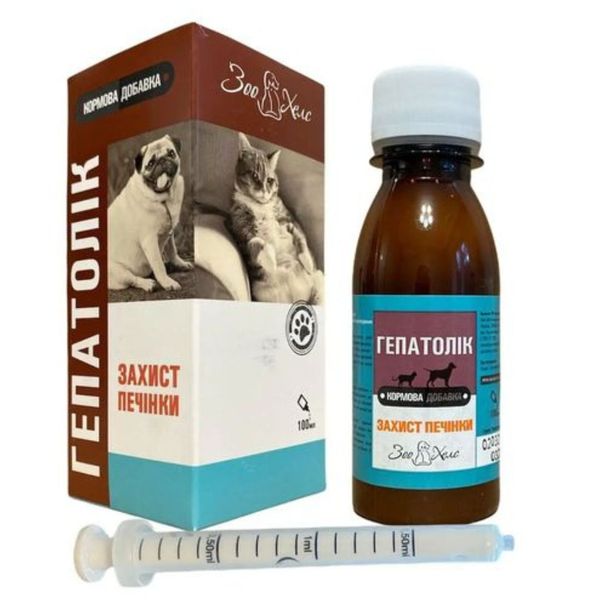|
Quantity
|
Out of stock
|
||
|
|
|||
🐕 HEPATOLIK 100 ml 🐈 sweet oral hepatoprotector
🚑Hepatolik is prescribed to dogs and cats in acute and chronic liver diseases of various etiologies, to normalize liver function and regeneration after endo- and exotoxicosis, somatic and infectious diseases, as well as to reduce the negative impact of drugs with hepatotoxic effects
🟢 DOSAGE:
The preparation is used in dogs and cats orally, individually with a small amount of food or administered by force using a dosing syringe 2-3 times a day, for 3-5 weeks, in doses:
🔹 Cats - 1 ml per 3 kg of body weight (maximum 4 ml per animal)
🔹 Dogs - 1 ml per 10 kg of body weight (maximum 6 ml per animal)
Contraindication:
Increased individual sensitivity of the animal to feed additive components, hepatic encephalopathy and epilepsy.
🟢 COMPOSITION OF THE MEDICINE:
1 ml of the drug contains active substances:
🔹 essential phospholipids - 60 mg,
🔹 methionine - 100 mg,
🔹 L-ornithine - 50 mg,
🔹 milk thistle extract - 15 mg,
🔹 St. John's wort extract - 15 mg.
Excipients: potassium sorbate, sodium benzoate, xanthan gum, Tween-80, propylene glycol, distilled water.
🟢 PHARMACOLOGICAL PROPERTIES
ATСvet code QА05ВА. Complex functional feed additive for dogs and cats with liver diseases.
🔹 Hepatolic contains specific nutraceutical components that have membrane stabilizing, hepatoprotective, antioxidant properties. The complex of biologically active components improves the functional state of the liver and its detoxification function, helps to preserve and restore the structure of hepatocytes; normalizes the level of ammonia in the animal body, accelerates the regeneration of liver cells. 🔹The main component of the feed additive are the so-called essential phospholipids (EPL-substance), which are a highly purified fraction of phosphatidylcholine. The defining component of this fraction is dilinoleoylphosphatidylcholine. Essential phospholipids are chemically similar to endogenous membrane phospholipids, surpassing them in functional properties due to the high content of polyunsaturated fatty acids, especially linoleic acid. Phospholipids are the main structural elements of cell membranes and organelles. They participate in cell differentiation, division and regeneration. The functional value of phospholipids is based on their amphiphilic properties, which allow to regulate the permeability of the cell membrane. They improve the function of membranes, in particular ion exchange, the process of intracellular respiration, biological oxidation, affect the binding of enzymes of intracellular respiration in mitochondria, as well as the process of oxidative phosphorylation in energy exchange in cells. Under physiological conditions, phospholipid synthesis meets the normal needs of hepatocytes, which contain a sufficient amount of phospholipids. It is known that in liver diseases, the structure of cell membranes and the function of enzyme systems are disturbed. The biosynthesis of phospholipids is disturbed, the deficiency of which leads to a violation of the function of the cell membrane. These processes are especially pronounced in mitochondria, which consist of about 30% of phospholipids and in which the most important metabolic processes take place, including oxidative phosphorylation. With a deficiency of phospholipids, fat metabolism is disturbed, which leads to fatty dystrophy of the liver. Thanks to its pharmacological properties, Hepatolic eliminates the above disorders, supports the regeneration of cell membranes, reactivates disturbed membrane-enzymatic systems and receptors, increases the liver's detoxification capacity, and thus normalizes its functioning. 🔹 Methionine is an irreplaceable amino acid that participates in permethylation processes. It has a lipotropic effect, supports the synthesis of choline, phospholipids; participates in the synthesis of adrenaline, creatine; activates the action of hormones, vitamins, enzymes. It has detoxifying properties due to its ability to methylate toxic products. It reduces the concentration of cholesterol in the blood and increases the content of phospholipids. 🔹 L-ornithine is a non-protein amino acid (not used to create proteins), which is an intermediate link in the urea cycle. L-ornithine protects the liver from the toxic effects of various foods and pharmacological drugs. It also takes part in the reconstruction of liver cells, activating ornithine carbamoyltransferase and carbamoylphosphate synthetase I in periportal hepatocytes - the leading enzyme of the urea synthesis cycle.
🔹Sylimarin has a hepatoprotective effect through competitive interaction with receptors for appropriate toxins in the hepatocyte membrane, thus exerting a membrane-stabilizing effect, stimulates the synthesis of proteins (structural and functional) and phospholipids in damaged hepatocytes, thus accelerating regenerative processes. The action of flavonoids, to which silymarin belongs, is also determined by their antioxidant properties and the effect improving microcirculation.
🔹Immortelle extract improves the general functional condition of the liver, increases the formation of bile and acids bile ducts, improves the flow of bile through the bile ducts and enhances the secretory and motor functions of the digestive tract. It is widely used in various diseases of the liver, gallbladder and biliary tract: cholelithiasis, biliary dyskinesia, chronic cholecystitis, chronic hepatitis. Immortelle extract has a pronounced antispasmodic effect on the biliary tract and the gallbladder sphincter, which, in combination with a mild tonic effect on the gallbladder, leads to improved bile outflow, full release of the gallbladder and the end of biliary dyskinesia phenomena. The presence of resin acids in the immortelle extract provides antiparasitic action against giardia. Biologically active substances of immortelle have a comprehensive effect on the hepatobiliary zone, significantly improve the drainage function of the liver, ensuring reliable elimination of metabolic products and toxins with bile. In terms of the degree of impact on the body, Hepatolik belongs to low-hazard substances (hazard class 4 according to GOST 12.1.007-76), in therapeutic doses it does not have an embryotoxic, teratogenic, carcinogenic and sensitizing effect.
































